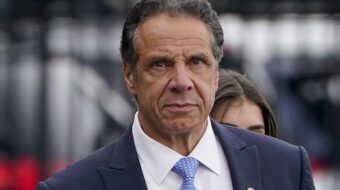
MovieREVIEW
Body of War
2007
Directed by Phil Donahue and Ellen Spiro
Mobilus Media, 87 min.
Shot in the collarbone on his fourth day of duty in Iraq, Tomas Young is the focus of this documentary by Phil Donahue and Ellen Spiro.
“Body of War” also follows the October 2003 vote in Congress that authorized President Bush to conduct a war in Iraq.
The editing often gives the film an extra kick.
For example, in October 2002 Bush spoke to the nation, and we see him make his case, one sentence at a time, to topple the partially-U.S.-armed Saddam Hussein regime. The film shifts to members of Congress debating the war. With the exception of a few who oppose it, the congressmen seem ridiculous. They’re excellent at repeating Bush’s lies verbatim. Sometimes they paraphrase and sometimes they embellish the original lie. We are unsure if we should laugh or cry. Layered with this is a voiceover of each vote of all the congressmen and senators.
Much of the footage focuses on Sen. Robert Byrd of West Virginia. His hands are shaky, his eyes failing, but his focus on the danger of handing the war authorization to the president is completely impressive. Quoting Nazi leader Herman Goering in 1934 Nazi Germany, Byrd shows the sordid history of lying as a recruitment tactic so a nation can have cannon fodder and recruit more bodies for war.
But the heart of the film lies in two years of the day-to-day world of Tomas Young and the emotional and physical aftermath of his injury in Iraq. A few days after 9/11, Young watched Bush’s speech at the crumbled heap of the World Trade Center. He decided to enlist in the U.S. military and ended up in Sadr City, Iraq, in an unprotected truck.
Young’s wounds left him paralyzed from the waist down. After minimum rehab at the VA he returned home. The film details his daily urinary tract infection threat, his penis dysfunction, the necessity of wearing a special vest with cold packs in it, and blood pressure that swings from 230/170 to 80/60. All this makes a powerful impact on the audience. Young and his family — his wife, mom, stepfather and brother — are featured in the film.
Young’s handsome face is freckled, with an accessible smile, red hair and a twinkle in his eye. He gets married, becomes active in Iraqi Veterans Against the War and spends his honeymoon at Camp Casey with Cindy Sheehan in Crawford, Texas, hounding Bush during his month-long vacation. He goes to antiwar protests in Washington, D.C., and appears on CBS’s “60 Minutes.”
After Young’s brother volunteers to go fight in Iraq, Young and his mother go to Fort Campbell, Ky., to see his brother off. During the film Young’s marriage disintegrates, while Young’s mother, in her own right a warrior for peace, is married to a man who has bought deeply into Bush’s fear propaganda. It is quite a set of contradictions.
Young tells us that it was clear from the beginning that he and his fellow troops were a truck full of soldiers with no cover and armor protection, just sitting ducks waiting for a sniper on a roof. He is a returning soldier wounded in war and barely receiving any VA care. It causes us to wonder, will this haunt the people of this country for years to come? Or will we sign up for a second tour of duty when the next great dictator lies well enough, for a new generation to become another group of the walking wounded and wheelchair-bound?
This insightful movie will likely follow the path of at least a dozen documentaries about Bush’s war policies in Afghanistan, Iraq and Guantanamo: It will hardly last a week at a few select theaters, while “Iron Man,” a summer blockbuster about a superhero involved with creating weapons of war, can gross over $100 million in the first weekend.









